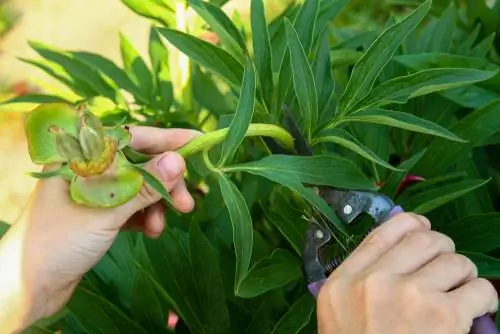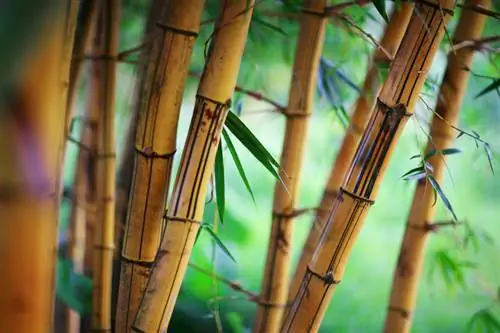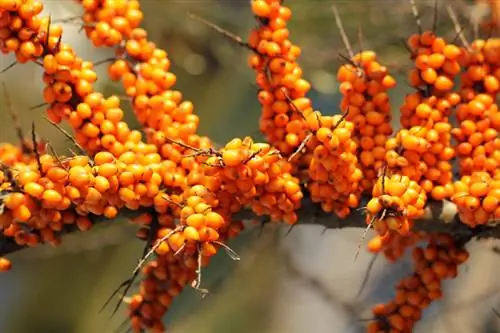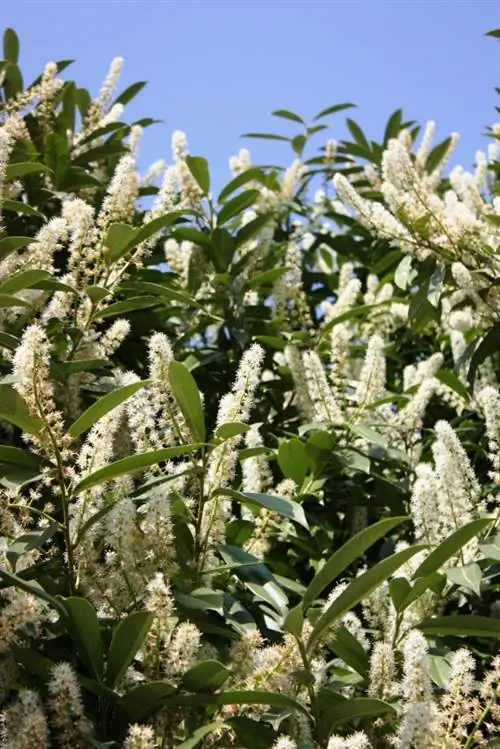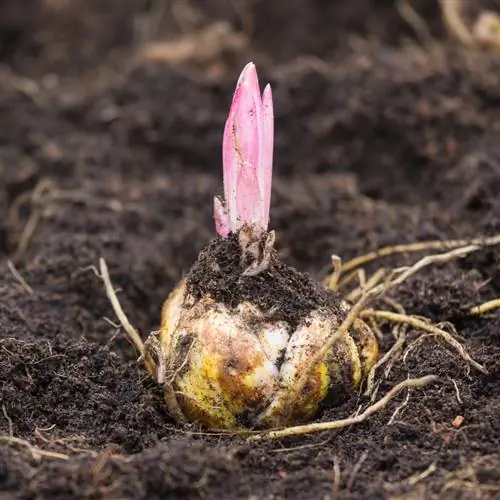- Author admin [email protected].
- Public 2023-12-16 16:46.
- Last modified 2025-06-01 06:02.
Many hobby gardeners are plagued by doubts when cutting peonies. This tutorial gets rid of the insecure feeling. Read here when and how to cut peonies correctly.
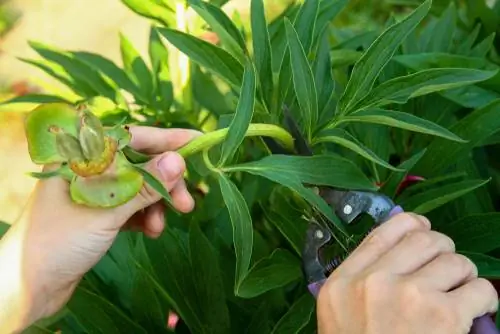
How do I cut peonies correctly?
Pruning peonies varies depending on the type: cut perennial peonies and Itoh hybrids close to the ground annually in late winter or autumn. Prune shrub peonies only when necessary and damaged in late winter to encourage branching or to remove damaged shoots.
Peonies - differences at a glance
Professional pruning care for peonies takes into accountstriking differences in growth. The following table provides a summary overview of the relevant categories with information on cutting requirements:
| Perennial Peonies | Intersectional (Itoh) Hybrids | Shrub peonies | |
|---|---|---|---|
| Growth | herbaceous shoots | woody base, predominantly herbaceous flower stems | shrub-like, completely woody |
| Cutting supplies | every year | every year | as required |
| best time to cut | Late winter (February/March) | Late winter (February/March) | Late winter (March) |
| alternative timing | Autumn | Autumn | none |
Autumn is not an alternative date for pruning shrub peonies as needed. The cause is the risk of frost damage. As with all shrubs, every cut results in adequate, initially herbaceous, soft shoots. Shortly before the onset of winter, the time window is not open long enough for fresh shoots to mature, become woody and be prepared for frost. Even just a few degrees below freezing point causes severe frost damage, which in the worst case can affect the entire peony bush.
Cut perennial peonies at ground level
Peonies in this category thrive with herbaceous shoots that bear impressive flowers in spring. These shoots come from so-called overwintering buds, which have spent the cold season deep in the ground on thickened roots. After the floral spring fairytale in the bed and pot, the shoots gradually wither and die off after the first frost. Ideally, the dead plant parts will continue to act as natural winter protection for some time. How to cut perennial peonies correctly:
- Best time is in late winter
- Alternatively, trim in autumn when all leaves and shoots have drawn in
- Cleaning and sharpening cutting tools
- Cut all shoots back to 5 to 10 cm
Thus, perennial peonies are no different from other garden perennials, such as phlox, aster or foxglove. The constant alternation between growth and decay with a frost-proof root as a starting point guarantees that the floral splendor unfolds anew every year. The primary task of pruning care is to create space for fresh shoots.
If you decide to prune in autumn, please be sure to wait until all parts of the plant arecompletely absorbed. This process is important for the survival of your peony. Important nutrients are transferred from the old leaves to the rootstock as an energy reserve for next year's shoots.
Excursus
Cleaning promotes blooms
When inspecting your garden in spring, have a pair of scissors handy. Regularly cleaning out withered flowers increases the abundance of flowers and improves the chances of lavish re-blooming. On perennial peonies, cut back dead stems to 10 centimeters above the ground or just the withered inflorescence. On shrub peonies, remove withered flowers until just above the next pair of he althy leaves. This cut clears the way for previously shaded or dormant buds, which are then brought to life by sunlight.
Cut Itoh hybrids moderately
Intersectional - Itoh for short - hybrids are a successful cross between shrub and perennial peonies. Each spring, strong stems sprout from a woody base and bear the picturesque flower heads. As a result, Itoh peonies play in the same league as popular subshrubs such as lavender or rosemary. However, Itoh hybrids have the advantage that they can sprout fresh shoots even from old wood. How to properly prune intersectional peony varieties:
- The best time is in late winter, in good time before budding begins
- Place the scissors over the woody shoot bases
- Ideally cut slightly at an angle close to one eye
The woody parts of a shoot should remain standing for good reason. These roots often contain valuable buds that sprout fresh in spring. However, the majority of this year's flower stems develop directly from the overwintering buds of the rootstock. There is therefore no cause for concern if one or two woody shoot stumps die in spring.
Tip
With bypass secateurs you are well equipped for pruning herbaceous peonies. With two sharp blades, smooth cutting surfaces are created and they close quickly. Rose or vine scissors, which ideally also have a bypass mechanism, are perfect for cutting into woody shoots. To thin out an old shrub peony, master the wood with an agile folding saw.
Cut bush peonies if necessary
For shrub peonies, a pruning date is rarely noted on the care plan. In contrast to their herbaceous counterparts, the flowering bushes naturally develop a harmonious silhouette with abundant flowering wood. If left uncut, tree peonies gain in splendor and size over time, which cannot be improved by any pruning method. There are, of course, two exceptions that suggest using scissors or a saw:
Encourage branching
If ideal conditions do not exist at the location, shrub peonies are stingy in sprouting side branches. You don't have to be satisfied with two bare scaffold shoots. The sedate growth will get going by pruning the flowering bush vigorously in spring. How to proceed professionally:
- Prune sparsely branched ground shoots by half to two thirds
- Best interface: 5mm above a bud facing outward
- Deepest intersection: 30 cm above the ground
Measure the cutting circumference according to this rule of thumb: the sparser the current branching, the stronger the pruning. The growth law of top funding comes into play here. As a result, buds at shoot tips are preferred and supplied with nutrients under high pressure. By cutting off the upper parts of the shoots, the sap pressure on the remaining buds increases, which now sprout vigorously.
The radical cut has its price. At least for this year the flowering period is canceled. With a large portion of compost and horn shavings or a complete organic fertilizer you can support the flowering bush to grow again.
Repair snow pressure damage
Shrub peonies thrive on brittle wood. The branches break easily under the weight of large amounts of snow. If the crown is otherwise dense and evenly shaped, cut off the damaged shoot below the break point. Choose an eye on the outside as a starting point for scissors or saw so that the fresh wood grows in the right direction.
If there is significant damage caused by snow or storms, a rejuvenation cut will correct the problem. According to the Federal Nature Conservation Act, the period for deep tree pruning extends from October 1st to February 28th. Cut or saw off all main shoots to a height of 30 centimeters. Woody peonies sprout reliably from old wood if it is a well-rooted shrub. Under this condition, there is sufficient root pressure so that new shoots sprout from old branch stubs.
This video offers an easy-to-understand explanation of the difference between perennial and shrub peonies and the correct pruning care:

Background
Pruning optimizes shrub peonies
For perennial peonies and intersectional hybrids, you can delete a plant cutting without replacing it. If your peony thrives as a shrub, the beauty of its flowers will benefit from this type of pruning for the rest of its life. In the first spring after planting, cut off all shoots above the first or second bud from below. The resulting sap buildup causes vigorous branching at the base. The first flowering period falls victim to the cut. In return, you optimize a stable, stable shrub structure whose branches reliably support the heavy flower heads.
Frequently asked questions
Are peonies poisonous?
Unfortunately, the magnificent peonies also have a dark side, because they are filled with the poisonous alkaloid paeonin. If you like to decorate hot and cold dishes with colorful petals, peonies are not suitable for this purpose. Please do not use the green plant parts as food for pets such as hamsters, rabbits or budgies. Even horses, cows or goats can experience severe poisoning problems if they eat the clippings.
We would like to transplant our perennial peonies to a sunnier location. When is the best time? What should we pay attention to?
When perennial peonies gradually decline in autumn, it is the best time to change location. Cut all shoots back to 5 to 10 centimeters. Then dig up the root balls so that the plants can take as much soil with them as possible and only a little root mass is lost. Place peonies in the new location just as deep in the soil as before. The eyes on the tuberous roots should not be covered with soil higher than 5 cm. Make sure you have a sufficient water supply afterwards.
What is the difference between farmer's peony and tree peony in terms of pruning care?
A farmer's peony is also called a perennial peony because it thrives with herbaceous shoots. When it comes to pruning care, the opulent classics from the cottage garden are no different from other perennials. A cut back close to the ground in autumn or spring is enough for them to sprout again. In contrast, perennial peonies become woody from the base over the years. Their harmonious growth develops without regular pruning. An exception applies in the event of damage caused by snow pressure or to improve branching.
The half-shrub peony 'Cora Louise' has been growing uncut in our garden for several years. When and how far is a cut possible?
Self-shrub peonies, so-called Itoh hybrids, essentially behave like perennials. In autumn, leaves and shoots slowly dry out above ground. Throughout the winter, the dead plant parts naturally protect the rootstock from moisture and frost. Before budding appears in late winter, you can cut off the peony just above the woody shoot bases. Please pay attention to whether and where new buds are already appearing. There is no cut in these places or you place the scissors a little higher.
Are peonies just as affected by soil fatigue as roses?
Indeed it is. Do not plant new peonies in a location where peonies have already established themselves. Otherwise, stunted growth is inevitable as a result of soil fatigue. If there has been a peony in this spot in the previous 2 years, replacing the soil can solve the problem. In all other cases, we recommend a break of at least 4 years before establishing peonies again.
The 3 most common cutting mistakes
On an uncut perennial peony, this year's shoots have a hard time making their way through the dead leaves. Anyone who likes to let nature run its course in the garden will therefore struggle with their peonies' laziness when it comes to flowering. This does not apply to shrubby peony species, which cannot be cut like a perennial, but can only be used with scissors when necessary. The following table summarizes the three most common pruning mistakes on peonies with tips for expert prevention:
| Cutting errors | malicious image | Prevention |
|---|---|---|
| Perennial peony never cut | decreasing flowering ability | prune every year in late winter |
| Shrub peony cut like a perennial | uneven growth, dense network of thin shoots | Shrub peony only blend if necessary |
| not cleaned up | unkempt appearance, short flowering period | cut off wilted flowers |
Sly pests and pathogens speculate that there is another common lapse in pruning care. The uninvited guests prefer to use contaminated cutting tools as a means of transport to gain access to peonies this way. Please do not neglect to treat the blade or saw blade with hot water and spirit before and after a cut.
Tip
Peonies like to celebrate their picturesque flower festival indoors. All peonies are suitable for vase cutting, regardless of their species and variety. Cut flower shoots with solid-colored buds that feel nice and soft when lightly pressed. Ideally, you should leave two leaves per stem above the water to supply the flowers. To ensure that the plant can cope with the vase cut, you should cut out a maximum of a third of the flower stems.

